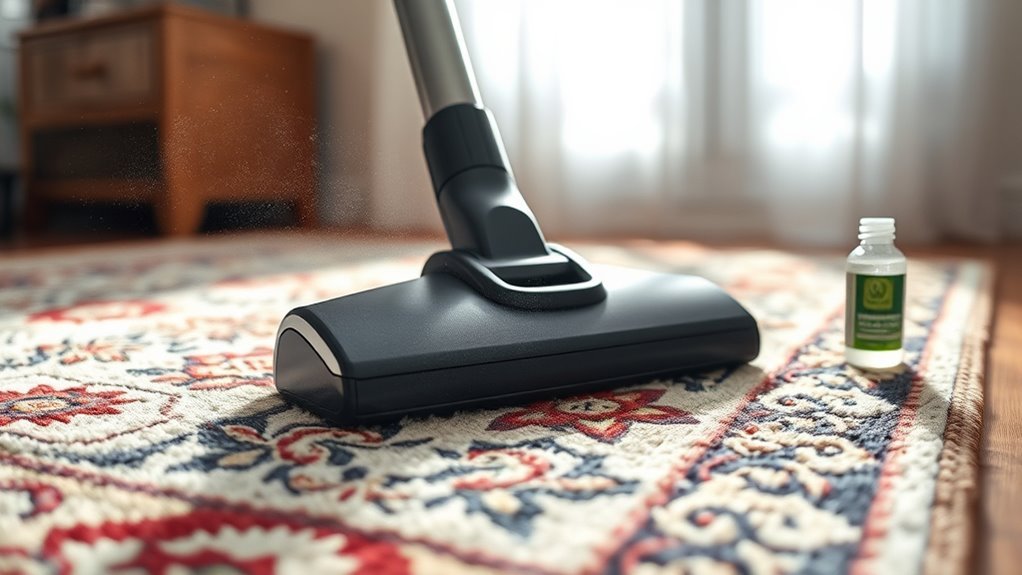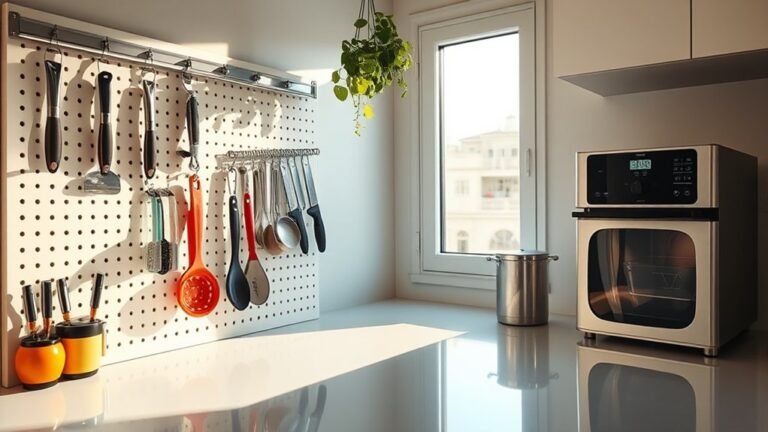Best Way to Sanitize Your Rug
To sanitize your rug effectively, start by identifying its material since wool and silk need gentle, pH-neutral cleaners, while synthetics can handle stronger solutions. Vacuum thoroughly to remove dirt, then spot-treat stains using suitable natural solutions like diluted vinegar or baking soda mixtures. If using steam cleaners, adjust settings carefully to avoid damage. After cleaning, dry your rug in a well-ventilated spot, keeping it off direct sunlight. Follow these steps, and you’ll keep your rug fresh and healthy. Explore further tips for deeper care.
Understanding Different Types of Rugs

Before you choose a sanitizing method, it is crucial to understand the type of rug you have, as different materials and weaves require specific care to avoid damage. Rug materials like wool, cotton, synthetic fibers, and silk each react differently to cleaning agents and moisture. For instance, wool is durable but sensitive to harsh chemicals, while silk demands gentle handling. Additionally, rug patterns influence cleaning techniques; intricate designs often mean tighter weaves that can trap dirt, requiring careful attention. Knowing your rug’s material and pattern helps you select a sanitizing approach that preserves its integrity and vibrancy. By tailoring your method to these factors, you guarantee effective sanitization without compromising the rug’s quality, giving you the freedom to maintain a clean, beautiful space confidently.
Importance of Regular Rug Sanitization
Knowing the specific materials and construction of your rug sets the foundation for proper care, but understanding why you should sanitize it regularly is just as significant. Regular sanitization offers essential health benefits by eliminating harmful bacteria and germs that accumulate over time. It also plays an important role in allergen reduction, helping to minimize dust mites, pollen, and pet dander that can trigger allergic reactions. Beyond health, consistent sanitizing preserves your rug’s appearance and extends its lifespan.
By sanitizing your rug regularly, you’ll:
- Improve indoor air quality and create a healthier living environment
- Reduce allergy symptoms for you and your family
- Protect your investment by preventing material degradation
This routine care grants you freedom from worry, ensuring your space stays fresh and safe.
Choosing the Right Cleaning Products

When selecting cleaning products for your rug, you’ll want to take into account both the rug’s material and the type of stains or dirt you’re targeting. Opt for eco friendly products whenever possible, as they minimize chemical considerations and reduce harmful residues. Avoid harsh chemicals on delicate fibers to preserve your rug’s integrity. Here’s a quick guide:
| Rug Material | Recommended Cleaning Product |
|---|---|
| Wool | pH-neutral, eco friendly shampoo |
| Synthetic | Mild detergent, eco friendly |
| Silk | Specialized silk cleaner |
| Cotton | Enzyme-based, eco friendly |
| Blends | Gentle, low-chemical formulas |
Choosing the right product lets you sanitize effectively without compromising your rug’s texture or color, granting you freedom from harsh chemicals and ensuring longevity.
Preparing Your Rug for Sanitization
Although selecting the right cleaning product is essential, thoroughly preparing your rug guarantees the sanitization process is both effective and safe. Start by following a precise rug preparation checklist to avoid surprises during cleaning. Begin with rug inspection tips: check for fragile fibers, stains, or damages that need special attention. Next, remove any loose debris or objects that could obstruct sanitization. Finally, make certain your workspace is well-ventilated to allow quick drying and prevent mold growth.
- Examine the rug’s fabric and backing for delicate areas
- Clear the surface of all furniture and items
- Set up an airy environment to promote drying
Vacuuming Techniques for Effective Dirt Removal

You should vacuum your rug regularly to prevent dirt from embedding deep into the fibers, ideally at least once a week for high-traffic areas. Adjust your vacuum to the appropriate setting based on your rug’s pile height to avoid damage while maximizing debris removal. Using the right frequency and settings guarantees your rug stays cleaner longer, making sanitization more effective.
Proper Vacuuming Frequency
Several factors influence how often you should vacuum your rug to maintain cleanliness and extend its lifespan. Establishing a consistent vacuuming schedule is essential for effective rug maintenance and preventing dirt buildup that can damage fibers. Consider these key elements when setting your routine:
- Foot traffic: High-traffic areas demand more frequent vacuuming, often daily or every other day, while low-traffic zones can be vacuumed weekly.
- Allergies and pets: If you have pets or allergy sufferers, increase vacuuming frequency to reduce dander and dust mites.
- Rug material: Delicate fibers require gentler cleaning and less frequent vacuuming to avoid wear.
Optimal Vacuum Settings
Maintaining a regular vacuuming schedule is only part of the process; selecting the right vacuum settings plays a significant role in effectively removing dirt without damaging your rug. You’ll want to adjust your vacuum to achieve ideal suction—strong enough to lift dirt and debris embedded deep in fibers, but gentle enough to avoid pulling or fraying delicate threads. Many vacuums have adjustable height settings—choose the appropriate one based on your rug’s pile thickness. Don’t overlook vacuum attachments; using a brush or upholstery tool can help gently loosen dirt in tight spots or fringes without causing harm. By fine-tuning these settings, you’ll maintain your rug’s integrity while maximizing dirt removal, giving you both freedom from grime and confidence in your rug care routine.
Using Natural Solutions to Sanitize Rugs
You can effectively sanitize your rug using natural solutions like essential oils and vinegar, which offer antimicrobial properties without harsh chemicals. Adding a few drops of essential oils such as tea tree or lavender to your cleaning mix enhances odor control and boosts sanitization. Meanwhile, a diluted vinegar solution works as a gentle disinfectant that’s safe for most rug fibers, making it a practical choice for routine cleaning.
Essential Oils Benefits
Although chemical cleaners are common for sanitizing rugs, essential oils offer an effective natural alternative that you can easily incorporate into your cleaning routine. These oils not only sanitize but also provide aromatherapy benefits, enhancing your living space’s ambiance while keeping it fresh. You can create personalized oil blends tailored to your preferences and cleaning needs.
Here’s why essential oils stand out:
- They possess natural antimicrobial properties that help eliminate bacteria and fungi.
- Oil blends can mask odors, leaving your rug smelling pleasant without harsh chemicals.
- Their gentle nature guarantees your rug’s fibers remain intact, prolonging its life.
Vinegar Cleaning Method
When dealing with stubborn odors or stains, vinegar offers a powerful yet natural solution for sanitizing your rug without relying on harsh chemicals. One of the key vinegar benefits is its ability to neutralize odors and break down grime effectively. To get started, mix white vinegar and water using vinegar ratios of 1:1 for general cleaning or 1:3 for delicate fibers to avoid damage. Apply the solution with a spray bottle or cloth, gently scrubbing the area as needed. Afterward, blot excess moisture and allow your rug to air dry completely to prevent mold. This method not only refreshes your rug but also harnesses vinegar’s natural antimicrobial properties, giving you a safe, eco-friendly way to maintain your rug’s cleanliness and extend its life.
How to Use Steam Cleaners Safely on Rugs
Since steam cleaning can be highly effective yet potentially damaging if done incorrectly, it’s essential to understand the proper techniques before using a steam cleaner on your rug. Prioritize steam cleaner safety by always testing a small, inconspicuous area first. Keep rug material considerations in mind—natural fibers like wool require gentler steam and less moisture, while synthetic rugs handle steam more robustly. To use your steam cleaner safely:
Always test a hidden spot first and adjust steam settings based on your rug’s material for safe cleaning.
- Adjust the steam settings based on the rug’s fiber type.
- Avoid over-saturating the rug; excessive moisture causes mold and damage.
- Move the steam cleaner steadily to prevent fabric distortion or weakening.
Spot Cleaning Stains and Odors
When you spot a stain or odor on your rug, the first step is to identify the type of stain to choose the most effective cleaning method. You can create simple homemade solutions tailored to specific stains, using common household ingredients that are both safe and efficient. Additionally, applying targeted deodorizing techniques will help eliminate unpleasant smells without damaging the rug fibers.
Identifying Stain Types
How can you effectively tackle stains and odors on your rug without causing damage? The key is precise stain identification before applying any treatment. Knowing the type of stain helps you choose the safest and most effective cleaning method, preserving your rug’s fibers and colors.
Focus on these common stains to get started:
- Organic stains: Such as food, wine, or pet accidents, often require enzymatic cleaners.
- Oil-based stains: Like grease or makeup, which need solvents or degreasers.
- Dye stains: From ink or markers, often needing specialized removers.
Homemade Cleaning Solutions
Once you’ve identified the type of stain on your rug, you can select a homemade cleaning solution tailored to effectively break down the specific residue without harming the fibers. For protein-based stains like food or blood, mix cold water with a small amount of natural dish soap to gently lift the stain. For oily or greasy spots, a solution of baking soda and water can absorb and break down the oils without harsh chemicals. Vinegar diluted with water works well on various stains, balancing pH while disinfecting naturally. Always test your homemade solutions on a small, inconspicuous area first to verify colorfastness. Using these natural ingredients not only protects your rug but also gives you the freedom to clean confidently without relying on commercial products filled with unknown additives.
Deodorizing Techniques
Anyone dealing with stubborn odors on a rug knows that effective deodorizing goes beyond simply masking smells. To truly refresh your rug, you’ll need methods that neutralize odors at their source. Start by sprinkling baking soda liberally across the rug’s surface; let it sit for several hours or overnight to absorb moisture and odors, then vacuum thoroughly. For a natural fragrance boost, scatter dried citrus peels around the rug, which release essential oils that combat unwanted smells without harsh chemicals. For spot cleaning, mix a small amount of mild detergent with water, apply to the stain, and blot gently to avoid spreading odors. Remember, consistent maintenance is key to preserving your rug’s freshness and extending its life.
- Sprinkle baking soda, let sit, then vacuum
- Use dried citrus peels for natural odor control
- Spot clean with mild detergent and blot carefully
Drying Your Rug Properly After Cleaning
Although cleaning your rug thoroughly is crucial, drying it properly afterward is equally important to prevent mold growth and fabric damage. To dry your rug efficiently, focus on maximizing air circulation methods. Place your rug in a well-ventilated area, preferably outdoors or near a fan, to speed up moisture evaporation. Elevate the rug using drying racks or breathable rug drying materials like mesh grids to allow air flow beneath. Avoid direct sunlight for prolonged periods, as this can fade colors and weaken fibers. Rotate the rug periodically to guarantee even drying on both sides. Using these expert techniques not only preserves your rug’s integrity but also guarantees it’s fresh and ready for use, giving you the freedom to enjoy a clean, safe living space.
Preventative Measures to Keep Your Rug Clean Longer
Properly drying your rug after cleaning sets a solid foundation for maintaining its condition, but keeping it clean longer requires ongoing effort. To extend your rug’s life and appearance, you need to adopt smart rug maintenance tips and effective stain prevention strategies. Here’s how you can proactively protect your investment:
- Implement a no-shoes policy to reduce dirt and oils tracked onto your rug daily.
- Use protective mats in high-traffic areas to shield your rug from excessive wear and spills.
- Regularly vacuum and spot-clean to prevent soil buildup and address stains immediately, minimizing damage.
Frequently Asked Questions
Can Rug Sanitization Help Reduce Allergens in My Home?
Think of allergen reduction like clearing the fog from your windows—sanitizing your rug lifts away dust mites, pet dander, and pollen that hide deep within fibers. You’ll improve your home health by reducing these triggers, which often worsen allergies and respiratory issues. Regular sanitization not only freshens your living space but gives you practical control over indoor air quality, helping you breathe easier and enjoy a freer, healthier environment every day.
How Often Should Professional Rug Cleaning Be Scheduled?
When deciding on frequency recommendations for professional rug cleaning, aim for every 12 to 18 months to maximize cleaning benefits. However, if you have pets, allergies, or high foot traffic, you might want to schedule cleanings more often, like every 6 to 12 months. Regular professional cleaning not only extends your rug’s life but also keeps your living space healthier and fresher, giving you freedom from allergens and stubborn dirt.
Are There Specific Sanitizers Safe for Antique or Delicate Rugs?
When caring for antique rugs, you’ve got to choose delicate fabric sanitizers specifically designed to protect fibers without causing damage. Avoid harsh chemicals or bleach, as they can weaken antique rug care efforts. Instead, opt for pH-balanced, gentle sanitizers that eliminate bacteria yet preserve color and texture. Testing a small, hidden area first is smart—you’ll maintain your rug’s beauty while ensuring it’s hygienically clean, giving you peace of mind and freedom from worry.
Can Pets Affect the Frequency of Rug Sanitization?
Yes, pets definitely affect how often you should sanitize your rug. Pet dander, hair, and oils can accumulate quickly, leading to unpleasant odors and potential allergens. For effective odor control and a healthier environment, you’ll want to sanitize your rug more frequently if you have pets. Regular cleaning helps prevent buildup, ensuring your space stays fresh and allergen-free, giving you the freedom to enjoy your home without worry.
What Are Signs That My Rug Needs Urgent Sanitization?
Like a warning light on a dashboard, rug discoloration causes can signal urgent sanitization needs. If you notice patches fading or darkening unevenly, it’s time to act. Odor detection methods, such as sniffing close or using activated charcoal, help identify hidden smells indicating bacteria or mold buildup. Trust your senses and check regularly—addressing these signs promptly keeps your space fresh and your freedom to relax unhindered by dirt or allergens.






